语用学(期末)
- 格式:doc
- 大小:89.00 KB
- 文档页数:14

2014-2015学年第一学期语用学与英语教学课程考核(研究报告)题目:An analysis of Pragmatic Failure with Cross-cultural Communications学号(准考证号):1230100054姓名:焦凯丽专业:英语(教法方向)年级:2012级学院:外国语学院完成日期:2015年 1 月10日IntroductionThe Cross-cultural Pragmatics is a relatively young linguistic branch compared with the Traditional Linguistics and Structural Modern Linguistics. It attaches great importance to the research of cross-cultural characteristics. And the cross-cultural pragmatic failure is a common phenomenon in cross-cultural communication process. This paper focus on the analyzing of different kinds of pragmatic failures in our cross-cultural communication, at the same time, giving reflections and feedbacks on our English learning and Language teaching. Being in the rapid developed century of our human society, we should heighten the awareness of appropriating use of pragmatic language in our cross-cultural communication.Part I Theoretical basisBefore Noam Chomsky, Traditional Linguistics and Structural Modern Linguistics regarded language as a system of completely self-sufficient blocking structure, which put an emphasis on the vision field of language researches on the description of linguistic entity and put the language teaching on a cultural vacuum to conduct a rigid practice. But this failed to attach the expected research on the Social culture which affects the language how it affects the construction, comprehension and expression. As a result, linguistic theories couldn't resolve realistic problems of language. And often communicators who have learned some basic knowledge such as phonetic, lexicon and grammar still couldn't carry out proper and effective communication. The birth of sociolinguistics breaks through the research restriction of traditional linguistics and pragmatics and structural. It deepens people’s realization to linguistic social nature and construct a high qualified platform for the study of the Intercultural Communication. However, all kinds of failure still occur in the intercultural communication which influences the quality of international communication because communications cannot master enough foreign knowledge or acknowledge the culture feature of foreign nation. So the research of pragmatic failure in the cross-cultural communication has become a problem of important theoretic meaning and realistic value in the contemporary linguistic study.Cross-cultural Pragmatics is a relatively young linguistic branch, growing out of pragmatics and comparative linguistics, and introducing cultural factors into the research scope of pragmatics. It attracted great importance to the research of cross-cultural characteristics. Cross-cultural pragmatics is the study of the use of second language in cross-cultural speech communication when the pragmatic problem occurs. The conception pragmatic of pragmatic failure was formally proposed by the famous British scientist Jenny Thomas in her thesis "Cross一Cultural Pragmatic Failure" in 1983 which established a theoretical framework for the analysis of pragmatic failure and cultural transfer. She defines pragmatic failure as "inability to understand what is meant by what is said." Thus, Cross-cultural pragmatic failurecan refer to the misunderstanding and even conflict arising in the communication process because of the hearer's failure to catch discourse implication of the speaker accurately and because of his following improper output of utterances, which may be proper in his culture. The pioneer study of pragmatic failure in China goes to He Ziran and his fraternity. In 1984, they launched investigation into pragmatic differences between English and Chinese in reference to Thomas theory, and made known their results of investigation together with explanations about pragmatic failure. Cross-cultural pragmatic failure is a common phenomenon in cross-cultural communication process, in this process, the speaker disobeys the communication standard and social customs, ignores hearer's identity or status, harms the special cultural value of target language, causes the breaking off or failure of communication, makes communicating obstacles, then communication cannot achieve the expected results. Though there is no grammatical error, the wrong way of speaking or the improper performance makes the communication lose the expected effect.Part II Case studiesThere are many kinds of pragmatic failure in our cross-culture communication. First is about the phonetic pragmatic failure. A teacher who teach Chinese in England recalled that, ”My student, John is a typical English gentleman. When we walk down stairs, he always said that '请小心裸体(楼梯),下流,一起下流(下楼)吧。

语⽤学术语期末资料Definition1. B road context: any contextual information that is relevant to the working outof what the speaker overtly intends to mean, and to the successful and felicitous performance of speech acts.2. C onstancy under negation: a property of presupposition which dictates that apresupposition generated by the use of a lexical item or a syntactic structure remains the same when the sentence containing that lexical item or syntactic structure is negated.3. C onstative: an utterance that is employed to make an assertion or a statement.4. C ontext: any relevant features of the dynamic setting or environment in whicha linguistic unit is systematically used.5. C onventional implicature: a non-truth-conditional inference which is notdeductive in any general, natural way from the saying of what is said, but arises solely because of the conventional features attached to particular lexical items and/or linguistic constructions.6. C onversational implicature: a set of non-logical inferences which containsconveyed messages which are meant without being part of what is said in the strict sense. It is derived from the saying of what is said via the co-operative principle and its component maxims of conversation.7. C o-operative principle: the overarching principle put forward by Grice in histheory of conversational implicature, which determines the way in which language is used most efficiently and effectively to achieve rational interaction in communication.8. D eixis: the phenomenon whereby features of context of utterance or speech eventare encoded by lexical and/or grammatical means in a language.9. D irect speech act: a speech act whose illocutionary force and sentence type aredirectly matched. In addition, an explicit performative, which happens to be in the declarative form, is also taken to be a direct speech act, because it has its illiocutionary force explicitly named by the performative verb in the main part(or “matrix clause”) of the sentence.10. E ntailment: a semantic relation between propositions or sentences expressingpropositions.11. E xplicature: a term used in relevance theory which refers to an inferentialdevelopment of mone of the incomplete conceptual representations or logical forms encoded by an uttereance. In other words, an explicature functions to flesh out the linguistically given incomplete logical form of the sentence uttered, yielding fully propositional content.12. F ace: the public self-image that every member of a society claims for him orherself.13. I llocutionary act: an act or action intended to be performed by a speaker inuttering a linguistic expression, by virtue of the conventional force associated with it, either explicitly or implicitly.14. I ndirect speech act: a speech act whose illocutionary force and sentence typeare not directly matched.15. L ocutionary act: an act of producing meaningful linguistic expression.16. M axims of conversation: the term used by Grice for the nine subprinciples ofhis co-operative principle classified into four catagories: Quality, Quantity, Relation, and Manner. The co-operative principle and its associate maxims of conversation enjoin the speaker to make a well-founded, appropriately informative, and relevant contribution to communication in a perspicuous manner.1. What are locutionary, illocutionary, and perlocutionary acts? Illustrate with atleast an example.Three facets of a speech act:1)Locutionary act: the production of a meaningful linguistic expression. (1’)Illocutionary act: the action intended to be performed by a speaker in uttering a2)linguistic expression , by virtue of the conventional force associated with it, eitherexplicitly or implicitly. (1’)3)Perlocutionary act: the bringing about of consequences or effects on theaudience through the uttering of a linguistic expression, such consequences or effectsbeing special to the circumstances of the utterance. (1’)For example, one may utter “The gun is loaded”with the locutionary act of saying that sentence, the illocutionary act of warning or explanation, and theperlocutionary act might be that the hearer is scared to kneel down, or fight back, etc.(2’)2. Consider the use of here in (i)-(iv). What is the function of here? What are thedifferences?(i) I’m over here!(shouted to companion through the woods)(ii)Oh, it’s just beautiful here!(with sweeping arm gesture to countryside)(iii) Doctor, it hurts here.(with hand on abdomen)(iv) They live over here, but we live here.(pointing to a small map)These heres are called demonstrat ives and they are deictic adverbs of space. (1’)(i) The region referred to is restricted to the speaker’s place and excludes that of the addressee. (1’)(ii) The region referred to is of broad extent and includes both the speaker and the addressee(s). (1’)(iii) The place referred to is a small segment of the body of the speaker. (1’)(iv) The region referred to is a deferred place using a map in the common perceptual field of the interlocutors. (1’)3.When will presuppositions be canceledLike conversational implicatures, but unlike semantic entailments, presuppositions are cancelable. (1’)They are nullified if they are inconsistent with:(i) background assumptions,(ii) conversational implicatures, and(iii) certain discourse context. Furthermore, they can also drop out in certain contexts, some of which give rise to the projection problem of presupposition. (3’)?Defeasibility has in general been taken as the second most important property of presupposition. (1’)4.What are the three main types of cognitive effects to which the processing of new information in a context may give rise Illustrate them with a proper example, please.(i) generating a conclusion derivable from new and old information together, but from neither new nor old information separately, which is called a contextual implication, (1’)(ii) strengthening an existing assumption, (1’)(iii) contradicting and canceling an existing assumption. (1’)Suppose that a bus driver is to leave from a bus stop. He sees in his rear mirror the reflection of an anxious-looking woman carrying a bus pass, trying to cross the road behind him. In the first place, given the assumption that if a person is holding a bus pass, then he or she intends to travel on a bus, the derive will derive the new assumption or the contextual implication that the woman in question has the intention of traveling on his bus. Secondly, the bus driver’s existing assumption that the woman is trying to cross the road to catch his bus may be supported and strengthened by the assumption that she is carrying a bus pass. Thirdly, the driver’s existing assumption that the woman intends to take his bus is contradicted and eliminated when he sees the woman walk off in the opposite direction handing the bus pass to someone who is standing by the bus stop. (2’)PPP19 What is context? Why is it so important to pragmatics?C ontext: any relevant features of the dynamic setting or environment inwhich a linguistic unit is systematically used.。
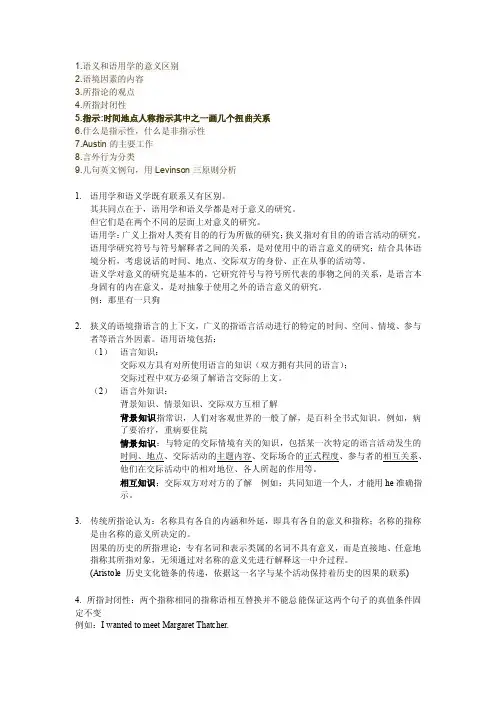
1.语义和语用学的意义区别2.语境因素的内容3.所指论的观点4.所指封闭性5.指示:时间地点人称指示其中之一画几个扭曲关系6.什么是指示性,什么是非指示性7.Austin的主要工作8.言外行为分类9.几句英文例句,用Levinson三原则分析1.语用学和语义学既有联系又有区别。
其共同点在于,语用学和语义学都是对于意义的研究。
但它们是在两个不同的层面上对意义的研究。
语用学:广义上指对人类有目的的行为所做的研究;狭义指对有目的的语言活动的研究。
语用学研究符号与符号解释者之间的关系,是对使用中的语言意义的研究;结合具体语境分析,考虑说话的时间、地点、交际双方的身份、正在从事的活动等。
语义学对意义的研究是基本的,它研究符号与符号所代表的事物之间的关系,是语言本身固有的内在意义,是对抽象于使用之外的语言意义的研究。
例:那里有一只狗2.狭义的语境指语言的上下文,广义的指语言活动进行的特定的时间、空间、情境、参与者等语言外因素。
语用语境包括:(1)语言知识:交际双方具有对所使用语言的知识(双方拥有共同的语言);交际过程中双方必须了解语言交际的上文。
(2)语言外知识:背景知识、情景知识、交际双方互相了解背景知识指常识,人们对客观世界的一般了解,是百科全书式知识。
例如,病了要治疗,重病要住院情景知识:与特定的交际情境有关的知识,包括某一次特定的语言活动发生的时间、地点、交际活动的主题内容、交际场合的正式程度、参与者的相互关系、他们在交际活动中的相对地位、各人所起的作用等。
相互知识:交际双方对对方的了解例如:共同知道一个人,才能用he准确指示。
3.传统所指论认为:名称具有各自的内涵和外延,即具有各自的意义和指称;名称的指称是由名称的意义所决定的。
因果的历史的所指理论:专有名词和表示类属的名词不具有意义,而是直接地、任意地指称其所指对象,无须通过对名称的意义先进行解释这一中介过程。
(Aristole 历史文化链条的传递,依据这一名字与某个活动保持着历史的因果的联系)4. 所指封闭性:两个指称相同的指称语相互替换并不能总能保证这两个句子的真值条件固定不变例如:I wanted to meet Margaret Thatcher.I wanted to meet the first woman Prime Minister of Great Britain.因为专有名词重名,确定性描述语有指称性和归属性两种用法等因素。
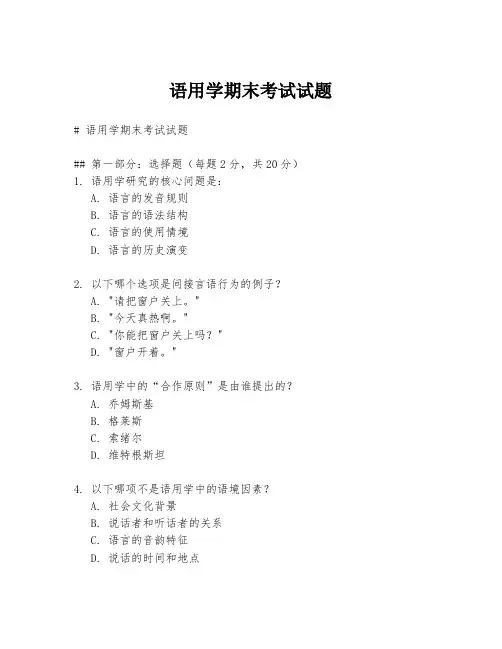
语用学期末考试试题# 语用学期末考试试题## 第一部分:选择题(每题2分,共20分)1. 语用学研究的核心问题是:A. 语言的发音规则B. 语言的语法结构C. 语言的使用情境D. 语言的历史演变2. 以下哪个选项是间接言语行为的例子?A. "请把窗户关上。
"B. "今天真热啊。
"C. "你能把窗户关上吗?"D. "窗户开着。
"3. 语用学中的“合作原则”是由谁提出的?A. 乔姆斯基B. 格莱斯C. 索绪尔D. 维特根斯坦4. 以下哪项不是语用学中的语境因素?A. 社会文化背景B. 说话者和听话者的关系C. 语言的音韵特征D. 说话的时间和地点5. 语用学中的“礼貌原则”包括哪些子原则?A. 量准则、质准则、关系准则、方式准则B. 量准则、质准则、方式准则、目的准则C. 质准则、关系准则、方式准则、目的准则D. 量准则、关系准则、方式准则、目的准则## 第二部分:简答题(每题10分,共30分)1. 解释“言语行为”理论中的“言内行为”、“言外行为”和“言后行为”。
2. 描述“隐喻”在语用学中的作用及其对语言理解的影响。
3. 阐述“语境”在语言交流中的重要性,并举例说明。
## 第三部分:论述题(每题25分,共50分)1. 论述“预设”在语言交流中的作用及其可能引起的误解。
2. 分析“指示语”在不同语境下的变化,并讨论其对交流的影响。
## 第四部分:案例分析题(共30分)阅读以下对话,并分析其中涉及的语用学概念:- A: “你昨天去图书馆了吗?”- B: “如果我去了,我就不会问你借书了。
”请从语用学的角度,分析B的回答中隐含的意思,并讨论这种交流方式在日常生活中的应用。
请注意,以上试题仅为示例,实际考试内容和形式可能有所不同。
考生应根据具体的教学大纲和课程内容进行复习准备。
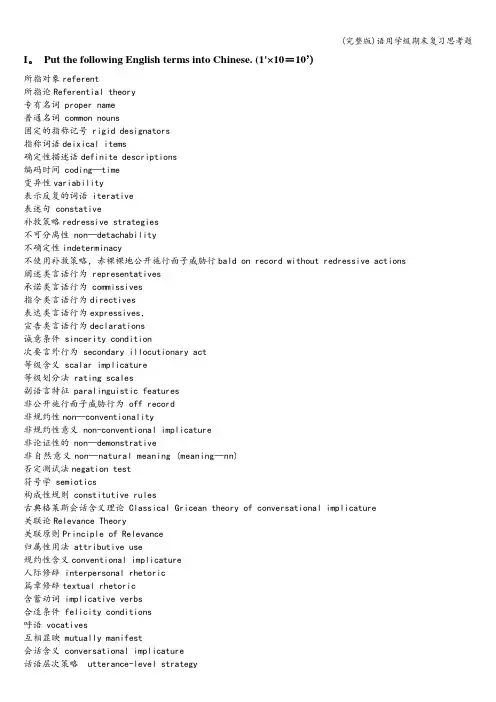
I。
Put the following English terms into Chinese. (1'×10=10’)所指对象referent所指论Referential theory专有名词 proper name普通名词 common nouns固定的指称记号 rigid designators指称词语deixical items确定性描述语definite descriptions编码时间 coding—time变异性variability表示反复的词语 iterative表述句 constative补救策略redressive strategies不可分离性 non—detachability不确定性indeterminacy不使用补救策略,赤裸裸地公开施行面子威胁行bald on record without redressive actions 阐述类言语行为 representatives承诺类言语行为 commissives指令类言语行为directives表达类言语行为expressives,宣告类言语行为declarations诚意条件 sincerity condition次要言外行为 secondary illocutionary act等级含义 scalar implicature等级划分法 rating scales副语言特征 paralinguistic features非公开施行面子威胁行为 off record非规约性non—conventionality非规约性意义 non-conventional implicature非论证性的 non—demonstrative非自然意义non—natural meaning (meaning—nn)否定测试法negation test符号学 semiotics构成性规则 constitutive rules古典格莱斯会话含义理论 Classical Gricean theory of conversational implicature关联论Relevance Theory关联原则Principle of Relevance归属性用法 attributive use规约性含义conventional implicature人际修辞 interpersonal rhetoric篇章修辞textual rhetoric含蓄动词 implicative verbs合适条件 felicity conditions呼语 vocatives互相显映 mutually manifest会话含义 conversational implicature话语层次策略 utterance-level strategy积极面子positive face间接言语行为 indirect speech acts间接指令 indirect directives结语 upshots交际意图communicative intention可撤销性 cancellability可废弃性 defeasibility可推导性 calculability跨文化语用失误cross—cultural pragmatic failure跨文化语用学cross—cultural pragmatics命题内容条件 propositional content condition面子保全论 Face-saving Theory面子论 Face Theory面子威胁行为 Face Threatening Acts (FTAs)蔑视 flouting明示 ostensive明示-推理模式ostensive—inferential model摹状词理论Descriptions粘合程度 scale of cohesion篇章指示 discourse deixis前提 presupposition前提语 presupposition trigger强加的绝对级别absolute ranking of imposition确定谈话目的 establishing the purpose of the interaction确定言语事件的性质 establishing the nature of the speech event 确定性描述语 definite descriptions认知语用学 cognitive pragmatics上下文 co—text社会语用迁移sociopragmatic transfer社交语用失误 sociopragmatic failure施为句 performative省力原则 the principle of least effort实情动词 factive verbs适从向 direction of fit手势型用法 gestural usage首要言外行为 primary illocutionary act双重或数重语义模糊 pragmatic bivalence/ plurivalence顺应的动态性 dynamics of adaptability顺应性adaptability语境关系的顺应(contextual correlates of adaptability)、语言结构的顺应(structural objects of adaptability)、顺应的动态性(dynamics of adaptability)和顺应过程的意识程度(salience of the adaptation processes)。
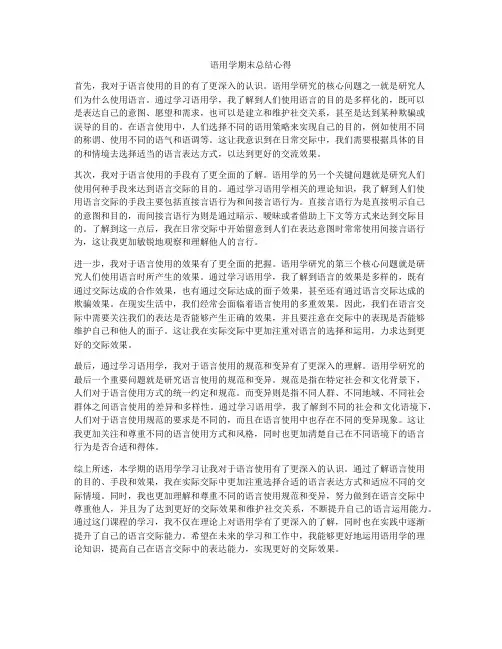
语用学期末总结心得首先,我对于语言使用的目的有了更深入的认识。
语用学研究的核心问题之一就是研究人们为什么使用语言。
通过学习语用学,我了解到人们使用语言的目的是多样化的,既可以是表达自己的意图、愿望和需求,也可以是建立和维护社交关系,甚至是达到某种欺骗或误导的目的。
在语言使用中,人们选择不同的语用策略来实现自己的目的,例如使用不同的称谓、使用不同的语气和语调等。
这让我意识到在日常交际中,我们需要根据具体的目的和情境去选择适当的语言表达方式,以达到更好的交流效果。
其次,我对于语言使用的手段有了更全面的了解。
语用学的另一个关键问题就是研究人们使用何种手段来达到语言交际的目的。
通过学习语用学相关的理论知识,我了解到人们使用语言交际的手段主要包括直接言语行为和间接言语行为。
直接言语行为是直接明示自己的意图和目的,而间接言语行为则是通过暗示、暧昧或者借助上下文等方式来达到交际目的。
了解到这一点后,我在日常交际中开始留意到人们在表达意图时常常使用间接言语行为,这让我更加敏锐地观察和理解他人的言行。
进一步,我对于语言使用的效果有了更全面的把握。
语用学研究的第三个核心问题就是研究人们使用语言时所产生的效果。
通过学习语用学,我了解到语言的效果是多样的,既有通过交际达成的合作效果,也有通过交际达成的面子效果,甚至还有通过语言交际达成的欺骗效果。
在现实生活中,我们经常会面临着语言使用的多重效果。
因此,我们在语言交际中需要关注我们的表达是否能够产生正确的效果,并且要注意在交际中的表现是否能够维护自己和他人的面子。
这让我在实际交际中更加注重对语言的选择和运用,力求达到更好的交际效果。
最后,通过学习语用学,我对于语言使用的规范和变异有了更深入的理解。
语用学研究的最后一个重要问题就是研究语言使用的规范和变异。
规范是指在特定社会和文化背景下,人们对于语言使用方式的统一约定和规范。
而变异则是指不同人群、不同地域、不同社会群体之间语言使用的差异和多样性。
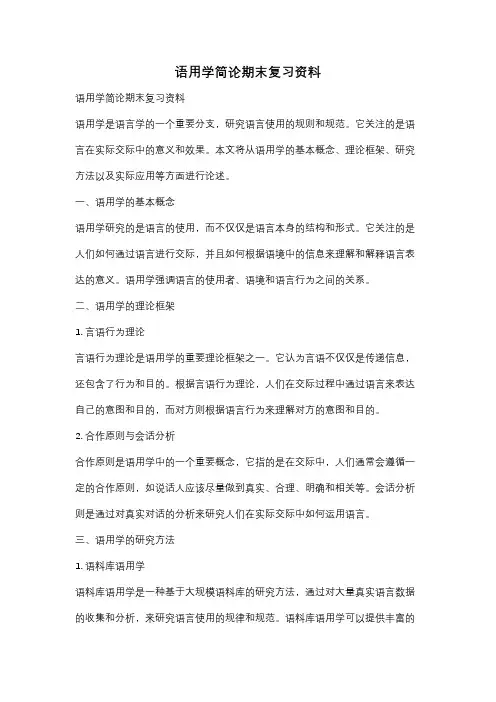
语用学简论期末复习资料语用学简论期末复习资料语用学是语言学的一个重要分支,研究语言使用的规则和规范。
它关注的是语言在实际交际中的意义和效果。
本文将从语用学的基本概念、理论框架、研究方法以及实际应用等方面进行论述。
一、语用学的基本概念语用学研究的是语言的使用,而不仅仅是语言本身的结构和形式。
它关注的是人们如何通过语言进行交际,并且如何根据语境中的信息来理解和解释语言表达的意义。
语用学强调语言的使用者、语境和语言行为之间的关系。
二、语用学的理论框架1. 言语行为理论言语行为理论是语用学的重要理论框架之一。
它认为言语不仅仅是传递信息,还包含了行为和目的。
根据言语行为理论,人们在交际过程中通过语言来表达自己的意图和目的,而对方则根据语言行为来理解对方的意图和目的。
2. 合作原则与会话分析合作原则是语用学中的一个重要概念,它指的是在交际中,人们通常会遵循一定的合作原则,如说话人应该尽量做到真实、合理、明确和相关等。
会话分析则是通过对真实对话的分析来研究人们在实际交际中如何运用语言。
三、语用学的研究方法1. 语料库语用学语料库语用学是一种基于大规模语料库的研究方法,通过对大量真实语言数据的收集和分析,来研究语言使用的规律和规范。
语料库语用学可以提供丰富的实证数据,从而支持语用学的理论研究。
2. 调查问卷和实验研究调查问卷和实验研究是语用学常用的研究方法。
通过设计问卷和实验,研究者可以获取被试者对于语言使用的态度、理解和解释等方面的数据,从而分析语言使用规律。
四、语用学的实际应用1. 跨文化交际语用学的研究成果可以应用于跨文化交际中。
不同的文化背景和价值观会影响人们对语言的理解和使用。
通过了解不同文化中的语用规范和交际习惯,人们可以更好地进行跨文化交际。
2. 社交媒体和网络交际随着社交媒体和网络交际的兴起,语用学在这一领域的应用也越来越重要。
人们在网络上的语言使用往往与实际交际有所不同,语用学可以帮助我们理解网络语言的特点和规律,从而更好地进行网络交际。
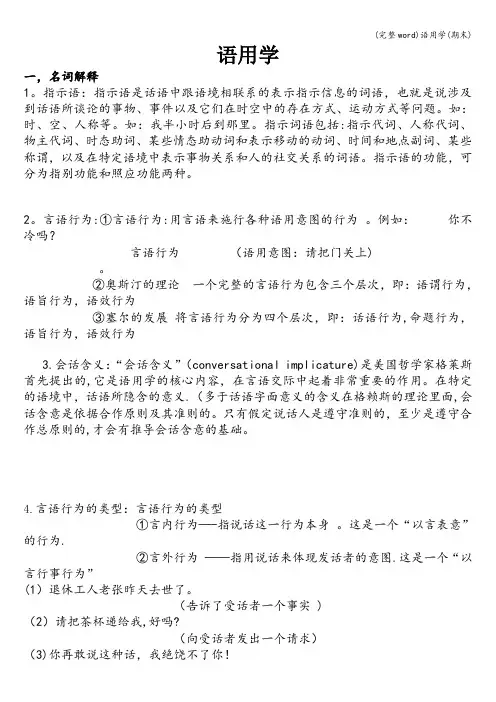
语用学一,名词解释1。
指示语:指示语是话语中跟语境相联系的表示指示信息的词语,也就是说涉及到话语所谈论的事物、事件以及它们在时空中的存在方式、运动方式等问题。
如:时、空、人称等。
如:我半小时后到那里。
指示词语包括:指示代词、人称代词、物主代词、时态助词、某些情态助动词和表示移动的动词、时间和地点副词、某些称谓,以及在特定语境中表示事物关系和人的社交关系的词语。
指示语的功能,可分为指别功能和照应功能两种。
2。
言语行为:①言语行为:用言语来施行各种语用意图的行为。
例如:你不冷吗?言语行为(语用意图:请把门关上)。
②奥斯汀的理论一个完整的言语行为包含三个层次,即:语谓行为,语旨行为,语效行为③塞尔的发展将言语行为分为四个层次,即:话语行为,命题行为,语旨行为,语效行为3.会话含义:“会话含义”(conversational implicature)是美国哲学家格莱斯首先提出的,它是语用学的核心内容,在言语交际中起着非常重要的作用。
在特定的语境中,话语所隐含的意义.(多于话语字面意义的含义在格赖斯的理论里面,会话含意是依据合作原则及其准则的。
只有假定说话人是遵守准则的,至少是遵守合作总原则的,才会有推导会话含意的基础。
4.言语行为的类型:言语行为的类型①言内行为—-指说话这一行为本身。
这是一个“以言表意”的行为.②言外行为——指用说话来体现发话者的意图.这是一个“以言行事行为”(1)退休工人老张昨天去世了。
(告诉了受话者一个事实 )(2)请把茶杯递给我,好吗?(向受话者发出一个请求)(3)你再敢说这种话,我绝饶不了你!(警告或威胁了受话者)(4)对不起,我来晚了. (向受话者道了歉)③言后行为-—指话语所带来的后果.这是一个“以言取效”的行为。
例如:(1)我明天会来的.(2)哥哥,你不要这样。
人家是好心好意来安慰我们. (《雷雨》)5会话原则:美国哲学家保罗。
格赖斯提出的会话原则旨在解释会话意义。
他提出自然语言有其独特的逻辑关系。
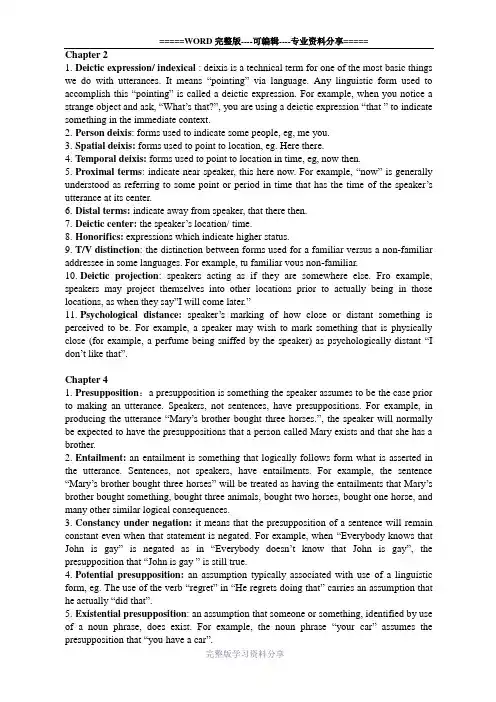
Chapter 21.Deictic expression/ indexical : deixis is a technical term for one of the most basic things we do with utterances. It means “pointing”via language. Any linguistic form used to accomplish this “pointing” is called a deictic expression. For example, when you notice a strange object and ask, “What’s that?”, you are using a deictic expression “that ” to indicate something in the immediate context.2.Person deixis: forms used to indicate some people, eg, me you.3.Spatial deixis: forms used to point to location, eg. Here there.4.Temporal deixis: forms used to point to location in time, eg, now then.5.Proximal terms: indicate near speaker, this here now. For example, “now” is generally understood as referring to some point or period in time that has the time of the speaker’s utterance at its center.6.Distal terms: indicate away from speaker, that there then.7.Deictic center: the speaker’s location/ time.8.Honorifics: expressions which indicate higher status.9.T/V distinction: the distinction between forms used for a familiar versus a non-familiar addressee in some languages. For example, tu familiar vous non-familiar.10.Deictic projection: speakers acting as if they are somewhere else. Fro example, speakers may project themselves into other locations prior to actually being in those locations, as when they say”I will come later.”11.Psychological distance:speaker’s marking of how close or distant something is perceived to be. For example, a speaker may wish to mark something that is physically close (for example, a perfume being sniffed by the speaker) as psychologically distant “I don’t like that”.Chapter 41.Presupposition:a presupposition is something the speaker assumes to be the case prior to making an utterance. Speakers, not sentences, have presuppositions. For example, in producing the utterance “Mary’s brother bought three horses.”, the speaker will normally be expected to have the presuppositions that a person called Mary exists and that she has a brother.2.Entailment: an entailment is something that logically follows form what is asserted in the utterance. Sentences, not speakers, have entailments. For example, the sentence “Mary’s brother bought three horses” will be treated as having the entailments that Mary’s brother bought something, bought three animals, bought two horses, bought one horse, and many other similar logical consequences.3.Constancy under negation: it means that the presupposition of a sentence will remain constant even when that statement is negated. For example, when “Everybody knows that John is gay”is negated as in “Everybody doesn’t know that John is gay”, the presupposition that “John is gay ” is still true.4.Potential presupposition:an assumption typically associated with use of a linguistic form, eg. The use of the verb “regret” in “He regrets doing that” carries an assumption that he actually “did that”.5.Existential presupposition: an assumption that someone or something, identified by use of a noun phrase, does exist. For example, the noun phrase “your car”assumes the6.Factive presupposition: the assumption that information stated after certain words, eg, “know”“regret”, is true. For example, the utterance that “I’m glad that it’s over” assumes the truth that “It’s over”.7.Lexical presupposition: the assumption that, in using one word, the speaker can act as if another meaning will be understood. For example, each time you say that someone “managed”to do something, the asserted meaning is that the person succeeded in some way.8.Structural presupposition: the assumption that part of a structure contained information being treated as already known. For example, the wh-question construction like “when did he leave?”, is interpreted with the presupposition that the information after the wh-form, “he left”, is already known to be the case.9.Non-factive presupposition:the assumption that certain information, like that associated with verbs “dream”, “imagine”and “pretend”, is not true. For example, when you say”I dreamed that I was rich”, the presupposition is that what follows the word “dreamed” is not true. That is “I was not rich.”10.Counter-factive presupposition:the assumption that certain information is the opposite of true. For example, a conditional clause like “If I had a car” presents the truth that I don’t have a car.11.Projection problem: the meaning of some presuppositions (as parts) doesn’t survive to become the meaning of some complex sentences (as wholes). For example, the presupposition “Kelly was ill”is assumed to be true in the simple structure “Nobody realized that Kelly was ill”. But it is not true in the complex structure that “I imagined that Kelly was ill and nobody realized that she was ill”.12.Background entailments: all logical consequence of an utterance. For example, the background entailments of “Rover chased three dogs”can be “something chased three dogs”, “Rover did something to three dogs”, or “Rover chased three of something” and so on.13.Foreground entailment: the main logical consequence of an utterance. For example, when Rover is the focus of the utterance “Rover chased three dogs”, the main assumption is that something chased three dogs.Chapter 51.Tautology: an apparently meaningless expression in which one word is defined as itself, eg. Business is business.2.Implicature/ Conversational implicature: an additional unstated meaning that has to be assumed in order to maintain the cooperative principle, eg. If someone says “The President is a mouse ”, something that is literally false, the hearer must assume the speaker means to convey more than is being said.3.Cooperative principle: a basic assumption in conversation that each participant will attempt to contribute appropriately, at the required time, to the current exchange of talk. Four sub-principles of the cooperative principle are called maxims:Quantity(1) make your contribution as informative as is required (for the current purposes of the exchange).(2) do not make your contribution more informative than is required.Try to make your contribution one that is true.(1)do not say what you believe to be false.(2)Do not say that for which you lack adequate evidence.RelationBe relevantMannerBe perspicuous.(1)avoid obscurity of expression.(2)Avoid ambiguity.(3)Be brief (avoid unnecessary prolixity).(4)Be orderly.4.HedgesCertain kinds of expressions speakers use to mark that they may be in danger of not fully adhering to the principles.Show speakers be cautious of the ...maximQuality: as far as I know I may be mistaken I’m not sure I guessQuantity: as you probably know to cut a long story short I won’t bore you with all the detailsRelation: I don’t know if this is important, but this may sound like a dumb question, butManner: this may be a bit confused, but I’m not sure if this makes sense I don’t know if this is clear at all.5.Generalized conversational implicature: an additional unstated meaning that does not depend on special or local knowledge. For example, phrases like a/an X are typically interpreted according to the generalized conversational implicature that: an X +> not speaker’s X6.Scalar implicature: an additional meaning of the negative of any value higher on the scale than the one uttered, e.g. In saying “some children”, I create an implicature that whatI say does not apply to “all children”.7.Particularized conversational implicature:an additional unstated meaning that depends on special or local knowledge. For example, here is a dialogue. Rick: Hey, coming to the wild party tonight ? Tom: My parents are visiting. In order to make Tom’s response relevant, Rick has to draw on some assumed knowledge that one college student in this setting expects another to have. Tom will be spending that evening with his parents, and time spent with parents is quiet (consequently +> Tom not at party).8.Conventional implicature: as additional unstated meaning associated with the use of a specific word, e.g. “A but B”implies a contrast between A and B, so “contrast”is a conventional implicature of “but”.Chapter 61.Speech act:an action performed by the use of an utterance to communicate, such as apology, complaint, compliment, invitation, promise, or request.2.Speech event: a set of circumstances in which people interact in some conventional way to arrive at some outcome.3.On any occasion, the action performed by producing an utterance will consist of threeLocutionary act: the basic act of utterance or producing a meaningful linguistic expression. If you have difficulty with actually forming the sounds and words to create a meaningful utterance in a language(for example,because it’s foreign or you are tongue-tied ), you might fail to produce a locutionary act.Illocutionary act/ force: the communicative force of an utterance. For example, we might utter “I’ve just made some coffee.”to make a statement, an offer, an explanation or for some other communicative purpose.Perlocutionary act/ effect:the effect of an utterance used to perform a speech act. For example, you will utter “I have just made some coffee” on the assumption that the hearer will recognize the effect you intended (for example, to account for a wonderful smell, or to get the hearer to drink some coffee).4.IFIDs illocutionary force indicating device: indication in the speaker’s utterance of the communicative force of that utterance. It is an expression where there is a slot for a performative verb that explicitly names the illocutionary act being performed. Like I promise you that I will see you later. Other IFIDs which can be identified are word order, stress and intonation.5.Performative verb: a verb that explicitly names the speech act, e.g. The verb “promise”in the utterance “I promise to be there”.6.Felicity conditions: the appropriate conditions for a speech act to be recognized as intended. For some clear cases, the performance will be infelicitous if the speaker is not a specific person in a special context. General conditions:preconditions on performing a speech act. For example, participants can understand the language being used and that they are not play-acting or being nonsensical. Content conditions:in order to count as a particular type of speech act, an utterance must contain certain features, e.g. A promise must be a future event. Preparatory conditions: specific requirements prior to an utterance in order for it to count as a particular speech act. For example, when I promise to do something, there are two preparatory conditions: the event will not happen by itself; the event will have a beneficial effect. Sincerity conditions:requirements on the genuine intentions of a speaker in order for an utterance to count as a particular speech act. For example, for a promise, the speaker genuinely intends to carry out the future action. Essential condition: in performing a speech act, a requirement that the utterance commits the speaker to the act performed. For example, by the act of uttering a promise, I thereby intend to create an obligation to carry out the action as promised.7.Performative hypothesis: a proposal that, underlying every utterance, there is a clause with a verb that identifies the speech act. The basic format is I (hereby) Vp you (that) U Explicit performative: a speech act containing a performative verb.I hereby order you that you clean up this mess.Implicit performative: a speech act without a performative verb. Clean up this mess! 8.Speech act classificationOne general classification system lists five types of general functions performed by speech acts: declarations, representatives, expressives, directives, and commissives. Declarations are those kinds of speech acts that change the world via their utterance. E.g.A judge pronouncing a sentence.Representatives are those kinds of speech acts that state what the speaker believes to be the case or not, like assertions, conclusions, and descriptions. The speaker makes words fitExpresssives are those kinds of speech acts that state what the speaker feels, like statements of pleasure,likes, pain,joy and so on. The speaker makes words fit the world of feeling. For example, I’m really sorry!Directives are those kinds of speech acts that speakers use to get someone else to do something, like commands, requests, orders, suggestions and so on. The speaker attempts to make the world fit the words via the hearer. For example, gimme a cup of coffee. Commissives are those kinds of speech acts that speakers use to commit themselves to some future action, like promises, threats, refusals and so on. The speaker undertakes to make the world fit the words via the speaker.9.Direct speech act: speech act where a direct relationship exists between the structure and communicative function of an utterance, e.g. Using an interrogative form (can you....?) to ask a question.10.Indirect speech act:speech act where an indirect relationship exists between the structure and communicative function of an utterance, e.g. The use of an interrogative (can you...?) not to ask a question, but to make a request (can you help me with this?)Chapter 71.Face means the public self-image of a person. It refers to that emotional and social sense of self that everyone has and expects everyone else to recognize.2.Politeness in an interaction, can then be defined as the means employed to show awareness of another person’s face.3.Face wants: a person’s expectations that their public self-image will be respected.4.FTA/Face threatening acts:utterance or action which threatens a person’s public self-image.5.Face saving act: utterance or action which avoids a potential threat to a person’s public self-image. For example, I’m going to tell him to stop that awful noise right now! Perhaps you could just ask him if he is going to stop soon because it is getting a bit late and people need to get to sleep.6.Negative face is the need to be independent, to have freedom of action, and not to be imposed on by others.7.Positive face is the need to be accepted, even liked, by others, to be treated as a member of the same group, and to know that his or her wants are shared by others.8.Negative politeness: a face saving act which is oriented to the person’s negative face will tend to show deference, emphasize the importance of the other’s time or concerns.9.Positive politeness: a face saving act which is concerned with the person’s positive face will tend to show solidarity, emphasize that both speakers want the same thing, and that they have a common goal.10.Off record: utterances not directly addressed to another.11.On record: utterances directly addressed to another.12.Bald on record: utterances, e.g. Orders, directly addressed to another where the illocutionary force is made explicit. For example, lend me your pen.13.Mitigating devices is expressions used to soften an imposition, eg please, would you.14.A positive politeness strategy leads the requester to appeal to a common goal, and even friendship, via expressions like “How about letting me use your pen?”15.A negative politeness strategy is an attempt to demonstrate awareness of another’s16.Solidarity strategy is the tendency to use positive politeness forms, emphasizing closeness between speaker and hearer. Eg. Come on, let’s go to the party. Everyone will be there. We will have fun.17.Deference strategy is the tendency to use negative politeness forms, emphasizing the hearer’s right to freedom. Eg. There’s going to be a party, if you can make it, it will be fun.18.Pre-sequencesOne way of avoiding risk of threatening others’ face is to provide an opportunity for the other to halt the potentially risky act.Pre-request:utterance before a request to check if a request can be made. Eg. Are you busy? Not really. Check over this memo. Okay.Pre-invitation: utterance before an invitation to check if an invitation can be made. Eg. Are you doing anything later? Oh, yeah, busy busy. Oh, okay.Pre-announcement: utterance before an announcement to check if an announcement can be made. Eg. Mom, guess what happened? Silence. Mom, you know what? Not right now, Jacy, I’m busy.(stop).。
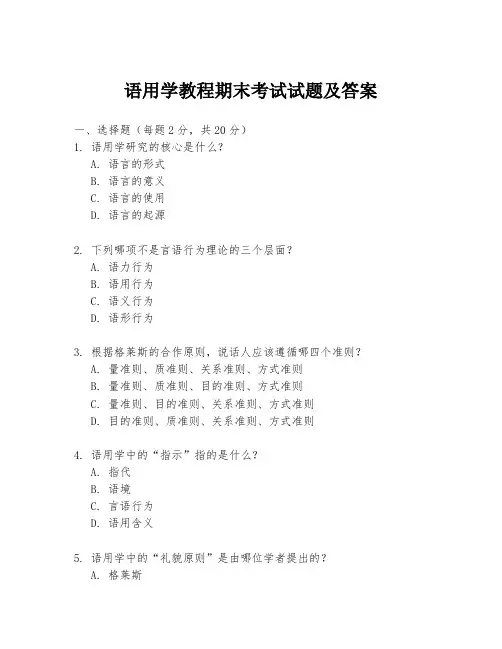
语用学教程期末考试试题及答案一、选择题(每题2分,共20分)1. 语用学研究的核心是什么?A. 语言的形式B. 语言的意义C. 语言的使用D. 语言的起源2. 下列哪项不是言语行为理论的三个层面?A. 语力行为B. 语用行为C. 语义行为D. 语形行为3. 根据格莱斯的合作原则,说话人应该遵循哪四个准则?A. 量准则、质准则、关系准则、方式准则B. 量准则、质准则、目的准则、方式准则C. 量准则、目的准则、关系准则、方式准则D. 目的准则、质准则、关系准则、方式准则4. 语用学中的“指示”指的是什么?A. 指代B. 语境C. 言语行为D. 语用含义5. 语用学中的“礼貌原则”是由哪位学者提出的?A. 格莱斯B. 布朗和莱文森C. 奥斯汀D. 赛尔...(此处省略其他选择题)二、简答题(每题10分,共30分)1. 简述语用学中的“隐喻”和“转喻”的区别。
2. 描述格莱斯的合作原则中的“量准则”。
3. 解释“言语行为”和“言语行为理论”的基本概念。
三、论述题(每题25分,共50分)1. 论述语用学在跨文化交际中的应用。
2. 分析并讨论“语境”在语用学中的重要性。
答案一、选择题1. C2. D3. A4. B5. B...(此处省略其他选择题答案)二、简答题1. 隐喻是一种通过将一个概念域映射到另一个概念域来表达意义的语言现象,而转喻则是通过将一个概念域中的某个元素与另一个概念域中的元素相联系来表达意义。
2. 量准则要求说话人在交际中提供足够的信息,既不多也不少,以满足交际的需要。
3. 言语行为是指说话人通过言语表达的意图,而言语行为理论是奥斯汀提出的,它将言语行为分为三个层面:语力行为、语义行为和语形行为。
三、论述题1. 语用学在跨文化交际中的应用主要体现在理解和解释不同文化背景下的言语行为,帮助人们避免误解和冲突,促进有效沟通。
2. 语境在语用学中的重要性体现在它对言语行为的理解和解释中起着决定性作用。

1、语用学术语的提出:1938年,美国哲学家莫里斯首先提出。
符号学包括句法学(研究符号和语义之间的形式关系)、语义学(研究符号与其对象的关系)、语用学(研究符号与解释者的关系)。
2、语用学的发展:1)语言哲学家巴尔—希勒尔于1954年提出语用学的具体研究对象是指引词语。
2)英国哲学家奥斯汀于1955年在哈佛大学做了题为《论言有所为》,提出“言语行为理论”。
3)美国语言哲学家格莱斯提出“会话含义理论”以及“合作原则”。
4)1977年,《语用学杂志》在荷兰的阿姆斯特丹正式出版发行,这是语用学作为语言学一门独立的新学科得到承认的标志。
5)1983年出版了语用学的两本优秀教材:列文森《语用学》、利奇《语用学原则》。
6)1986年,国际语用学学会在荷兰成立,并决定把《语用学杂志》作为学术刊物。
3、语用学的定义:语用学研究在不同语境中话语意义的恰当表达和准确理解,寻找并确立使话语意义得以恰当表达和准确理解的基本原则和准则。
4、语用学和语言学其他分支学科的关系:p95、语用学的研究方法:纯语用学、描写语用学、应用语用学。
6、“语境”是波兰人类语言学家马林诺夫斯基提出的。
7、陈望道在1932年出版的《修辞学发凡》中说:“修辞学以适应题旨情境为第一义,不应该是仅仅语辞的修饰,更不应是离开情意的修饰”。
“六何说”:何故、何事、何人、何地、何时、何如。
8、语境是人们运用自然语言进行语言交际的语言环境。
索振羽的划分p219、语境意义是在特定语境条件下,说话人希望传递的交际信息。
10、指示词语的组织形式:(自我—说话人为中心)1)中心人物是说话人;2)中心时间是说话人说话的时间;3)中心地点是说话人说话时所处的地点;4)语篇中心是一句话中说话人当时正说到的部位;5)社交中心是说话人相当于说话对象的社会地位。
11、指示词语的不同用法:1)指示用法:A、身势用法:指示词语只有借助对言语事件的实在的听觉、视觉、触觉才能理解。
B、象征用法:只需要知道言语事件的基本空间参数就可以理解。
1、语用学术语的提出:1938年,美国哲学家莫里斯首先提出。
符号学包括句法学(研究符号和语义之间的形式关系)、语义学(研究符号与其对象的关系)、语用学(研究符号与解释者的关系)。
2、语用学的发展:1)语言哲学家巴尔-希勒尔于1954年提出语用学的具体研究对象是指引词语。
2)英国哲学家奥斯汀于1955年在哈佛大学做了题为《论言有所为》,提出“言语行为理论”。
3)美国语言哲学家格莱斯提出“会话含义理论"以及“合作原则"。
4)1977年,《语用学杂志》在荷兰的阿姆斯特丹正式出版发行,这是语用学作为语言学一门独立的新学科得到承认的标志.5)1983年出版了语用学的两本优秀教材:列文森《语用学》、利奇《语用学原则》。
6)1986年,国际语用学学会在荷兰成立,并决定把《语用学杂志》作为学术刊物.3、语用学的定义:语用学研究在不同语境中话语意义的恰当表达和准确理解,寻找并确立使话语意义得以恰当表达和准确理解的基本原则和准则。
4、语用学和语言学其他分支学科的关系:p95、语用学的研究方法:纯语用学、描写语用学、应用语用学。
6、“语境”是波兰人类语言学家马林诺夫斯基提出的。
7、陈望道在1932年出版的《修辞学发凡》中说:“修辞学以适应题旨情境为第一义,不应该是仅仅语辞的修饰,更不应是离开情意的修饰”。
“六何说”:何故、何事、何人、何地、何时、何如。
8、语境是人们运用自然语言进行语言交际的语言环境.索振羽的划分p219、语境意义是在特定语境条件下,说话人希望传递的交际信息.10、指示词语的组织形式:(自我—说话人为中心)1)中心人物是说话人;2)中心时间是说话人说话的时间;3)中心地点是说话人说话时所处的地点;4)语篇中心是一句话中说话人当时正说到的部位;5)社交中心是说话人相当于说话对象的社会地位。
11、指示词语的不同用法:1)指示用法:A、身势用法:指示词语只有借助对言语事件的实在的听觉、视觉、触觉才能理解。
语用学期末总结在本学期的语用学课程中,我学习了语用学的基本概念、理论体系以及分析方法,对语言使用的规范、灵活性和多样性有了更深入的了解。
通过课堂学习、课后阅读和讨论,我对语用学的重要性、研究对象及其应用领域有了更清晰的认识,并且自己也积累了一定的语用分析经验。
在本文中,我将对本学期所学的内容进行总结和反思。
首先,语用学的基本概念和理论体系让我对语言使用的本质有了新的理解。
在过去,我主要关注的是语言的形式和结构,而对语言使用的目的、效果和交际功能关注较少。
通过学习语用学,我认识到语言不仅仅是一种符号系统,更重要的是它的实际运用。
语言是人类交流和思维的工具,它具有丰富多样的功能,在不同的语境中具有不同的意义和效果。
其次,语用学的主要研究对象包括言语行为、语用原则、话语和交际策略等。
言语行为是语言使用者通过语言表达出的行为意图,它可以分为直接言语行为和间接言语行为。
直接言语行为是指直接表达言语行为意图,如请求、命令、承诺等;间接言语行为则是通过暗示、建议、婉转表达等方式实现言语行为意图。
语用原则则是指人们在言语交际中遵循的一些原则,如合作原则、礼貌原则、含蓄原则等。
在本学期的课程中,我学习了Grice的合作原则和Sperber与Wilson的旨在沟通原则。
Grice的合作原则包括言语行为的最小变迁原则、话语行为合理性原则、言语行为合适性原则和言语行为模糊性原则。
这些原则指导着语言使用者在交流中如何选择合适的言语行为,在社会交往中维护良好的关系,使信息的交流更加有效。
Sperber与Wilson提出的旨在沟通原则则强调对话双方在交流过程中的认知目标和契合度,认为人们会不断地调整自己的语言使用,以达到更好的理解和沟通。
此外,我还学习了话语分析的基本概念和方法,包括对话分析、语篇分析、语用推理以及批评性话语分析等。
通过这些方法,我对日常对话和实际语料的分析能力得到了提升。
在课堂上,我通过老师的示范和指导,学会了如何分析对话的组织结构、信息交换方式、交流效果等。
语用学期末考试试题及答案一、选择题(每题2分,共20分)1. 语用学研究的核心是什么?A. 语言的语音学B. 语言的语法结构C. 语言的交际功能D. 语言的词汇学2. 以下哪个概念不属于语用学研究范畴?A. 语境B. 语义C. 语用失误D. 语音3. 语用学中的“合作原则”是由哪位学者提出的?A. 乔姆斯基B. 格莱斯C. 索绪尔D. 奥斯汀4. 以下哪个选项不是语用学中的言语行为?A. 陈述B. 命令C. 询问D. 描述5. 语用学中的“隐喻”属于哪种言语行为?A. 陈述B. 命令C. 询问D. 描述6. 以下哪个选项是语用学中的“言语行为”理论?A. 乔姆斯基的生成语法B. 奥斯汀的言语行为理论C. 索绪尔的结构主义D. 格莱斯的合作原则7. 语用学中的“礼貌原则”是由哪位学者提出的?A. 格莱斯B. 奥斯汀C. 索绪尔D. 乔姆斯基8. 语用学中的“语境”是指什么?A. 语言使用的物理环境B. 语言使用的文化环境C. 语言使用的社会环境D. 语言使用的所有环境因素9. 以下哪个选项不是语用学中的“语境”因素?A. 参与者B. 地点C. 时间D. 语法结构10. 语用学中的“预设”是指什么?A. 语言使用的前提条件B. 语言使用的逻辑结构C. 语言使用的语境因素D. 语言使用的语义内容二、简答题(每题10分,共30分)1. 简述语用学中的“合作原则”。
2. 举例说明“言语行为”理论中的“言外行为”。
3. 解释“礼貌原则”在交际中的作用。
三、论述题(每题25分,共50分)1. 论述语用学中的“语境”对语言理解和使用的影响。
2. 分析“隐喻”在交际中的功能及其在广告中的应用。
参考答案一、选择题1-5 C D B B D6-10 B D D C A二、简答题1. 合作原则是格莱斯提出的,它认为在交际中,参与者会遵循一系列原则以确保交际的有效性。
这些原则包括数量原则、质量原则、关联原则和方式原则。
2. 言外行为是奥斯汀言语行为理论中的概念,指的是言语行为中除直接表达的意义之外,还隐含的其他意义。
语用学期末考试题及答案一、选择题(每题2分,共20分)1. 语用学研究的核心是什么?A. 语言的形式B. 语言的功能C. 语言的规则D. 语言的演变答案:B2. 以下哪个选项不属于言语行为理论中的三个层次?A. 言内行为B. 言外行为C. 言后行为D. 言前行为答案:D3. 在语用学中,隐喻属于哪种言语行为?A. 陈述行为B. 指令行为C. 承诺行为D. 描述行为答案:A4. 以下哪个概念不是由格莱斯提出的合作原则?A. 质量准则B. 量准则C. 关联准则D. 礼貌原则答案:D5. 语用学中的“语境”指的是什么?A. 说话的地点B. 说话的时间C. 说话的背景D. 所有上述选项答案:D6. 以下哪个选项是语用学中的“预设”?A. 说话者和听话者共享的知识B. 说话者希望听话者接受的信息C. 说话者在言语中隐含的信息D. 听话者对言语的理解答案:C7. 以下哪个概念是由布朗和莱文森提出的?A. 合作原则B. 礼貌原则C. 语境原则D. 预设原则答案:B8. 以下哪个选项不是语用学中的推理类型?A. 归纳推理B. 演绎推理C. 类比推理D. 逻辑推理答案:D9. 语用学中的“指示”指的是什么?A. 指代说话者或听话者B. 指代时间和地点C. 指代言语行为D. 指代所有上述选项答案:B10. 以下哪个选项是语用学中的“言语行为”?A. 说话B. 写文章C. 完成一项任务D. 所有上述选项答案:D二、简答题(每题10分,共30分)1. 简述语用学中的“言外行为”是什么,并给出一个例子。
答案:言外行为指的是说话者通过言语表达的意图或目的,而不仅仅是言语的字面意义。
例如,当某人说“你能帮我关一下窗户吗?”时,其言外行为是请求对方关窗户。
2. 解释“礼貌原则”及其在日常生活中的应用。
答案:礼貌原则是由布朗和莱文森提出的,它指导人们在交流中如何以礼貌的方式表达自己,避免冒犯他人。
在日常生活中,人们通过使用委婉语、避免直接否定、使用礼貌用语等方式来遵循礼貌原则。
语用学期末考试题及答案一、选择题(每题2分,共20分)1. 语用学研究的核心是什么?A. 语言的语法结构B. 语言的发音规则C. 语言的使用和理解D. 语言的历史演变答案:C2. 以下哪项不是语境对语言理解的影响因素?A. 社会文化背景B. 物理环境C. 个人情感状态D. 语言的词序答案:D3. 语用学中的“合作原则”是由哪位学者提出的?A. 乔姆斯基B. 奥斯汀C. 格赖斯D. 索绪尔答案:C4. 在语用学中,“言外之意”通常指的是什么?A. 语言的字面意思B. 语言的隐含意义C. 语言的修辞手法D. 语言的语法结构答案:B5. 以下哪个选项不是语用学中的言语行为?A. 陈述B. 命令C. 询问D. 描述答案:D6. 语用学中的“礼貌原则”是由哪位学者提出的?A. 布朗和莱文森B. 格赖斯C. 奥斯汀D. 索绪尔答案:A7. 在语用学中,如何理解“语境”这一概念?A. 仅指语言使用的物理环境B. 仅指语言使用的社交环境C. 包括语言使用的物理环境和社交环境D. 仅指语言使用的文化环境答案:C8. 以下哪项不是语用学中的话语分析方法?A. 话语连贯性分析B. 话语结构分析C. 话语主题分析D. 语法结构分析答案:D9. 语用学中的“指示语”主要指的是什么?A. 指示时间的词语B. 指示地点的词语C. 指示说话人和听话人关系的词语D. 指示说话人和听话人身份的词语答案:C10. 在语用学中,如何理解“隐喻”这一概念?A. 一种修辞手法B. 一种语言错误C. 一种逻辑推理D. 一种语法结构答案:A二、简答题(每题5分,共30分)1. 简述语用学与语义学的主要区别。
答:语用学主要研究语言的使用和理解,关注语境对语言的影响,而语义学则关注语言的意义和结构。
2. 描述格赖斯的“合作原则”包含哪些准则。
答:合作原则包含四个准则:数量准则、质量准则、关联准则和方式准则。
3. 解释“礼貌原则”在交际中的作用。
答:礼貌原则指导人们在交际中遵循一定的规范,以减少冲突,维护和谐的社交关系。
第八章语言的使用复习笔记I.语用学1.定义语用学是研究语言实际运用的学科,集中研究说话人意义、话语意义或语境意义。
2.语用学和语义学的区别虽然语用学和语义学都是研究语言意义的学科,但是它们有着很大的差别:语用学主要研究在特定的语境中说话人所想要表达的意义,而语义学研究的是句子的字面意义,通常不考虑语境。
II.言语行为理论言语行为理论是牛津大学哲学家约翰·奥斯丁在他《如何以言行事》一文中提出的。
它从哲学意义上对语言交际的本质进行解释,其目的在于回答“用语言干什么”这个问题。
1.施为句和叙事句奥斯汀提出自己理论的第一步是把句子分成两类:施为句和叙事句。
它们不能应用于传统的真值判断方法。
因此,他对施为句和叙事句作了区分。
(1)定义施为句是用来做事的,既不陈述事实,也不描述情况,且不能验证其真假;叙事句要么用于陈述,要么用于验证,可以验证其真假。
(2)合适条件虽然施为句没有真假,但必须满足一定条件才是合适的。
我们把奥斯汀的合适条件简化如下:①必须有一个相应的规约程序,并且相关的参与者与环境是合适的。
②该程序必须正确全面地得到执行。
③有关人必须有相关的思想、感情和意图,而且必须有相关的后续行为。
但是奥斯汀很快就认识到,这些条件只适用于部分情况。
2.行事行为理论后来,奥斯汀放弃了他最初对叙事句和施为句所做的区分。
他建立了另一种模式来解释如何通过语言实施行为。
根据这种新的模式,说话人说话时可以完成三种行为:发话行为,行事行为和取效行为。
发话行为是说出词、短语、分句的行为,是通过句法、词汇和音位手段表达字面意义的行为。
行事行为是表达说话人意图的行为,是在说话过程中所完成的行为。
取效行为是通过说话完成或通过说话所产生的行为,是由话语所带来的结果和变化。
在上述三种言语行为中,语言学家最感兴趣的是行事行为,因为这种言语行为与说话人的意图一致。
在研究语言交际时,语言学家最感兴趣的是说话人如何表达他的意图和听话人如何识别说话人的意图。
语用学一,名词解释1.指示语:指示语是话语中跟语境相联系的表示指示信息的词语,也就是说涉及到话语所谈论的事物、事件以及它们在时空中的存在方式、运动方式等问题。
如:时、空、人称等。
如:我半小时后到那里。
指示词语包括:指示代词、人称代词、物主代词、时态助词、某些情态助动词和表示移动的动词、时间和地点副词、某些称谓,以及在特定语境中表示事物关系和人的社交关系的词语。
指示语的功能,可分为指别功能和照应功能两种。
2.言语行为:①言语行为:用言语来施行各种语用意图的行为。
例如:你不冷吗?言语行为(语用意图:请把门关上)。
②奥斯汀的理论一个完整的言语行为包含三个层次,即:语谓行为,语旨行为,语效行为③塞尔的发展将言语行为分为四个层次,即:话语行为,命题行为,语旨行为,语效行为3.会话含义:“会话含义”(conversational implicature)是美国哲学家格莱斯首先提出的,它是语用学的核心内容,在言语交际中起着非常重要的作用。
在特定的语境中,话语所隐含的意义。
(多于话语字面意义的含义在格赖斯的理论里面,会话含意是依据合作原则及其准则的。
只有假定说话人是遵守准则的,至少是遵守合作总原则的,才会有推导会话含意的基础。
4.言语行为的类型:言语行为的类型①言内行为——指说话这一行为本身。
这是一个“以言表意”的行为。
②言外行为——指用说话来体现发话者的意图。
这是一个“以言行事行为”(1)退休工人老张昨天去世了。
(告诉了受话者一个事实)(2)请把茶杯递给我,好吗?(向受话者发出一个请求)(3)你再敢说这种话,我绝饶不了你!(警告或威胁了受话者)(4)对不起,我来晚了。
(向受话者道了歉)③言后行为——指话语所带来的后果。
这是一个“以言取效”的行为。
例如:(1)我明天会来的。
(2)哥哥,你不要这样。
人家是好心好意来安慰我们。
(《雷雨》)5会话原则:美国哲学家保罗.格赖斯提出的会话原则旨在解释会话意义。
他提出自然语言有其独特的逻辑关系。
他认为会话的最高原则是合作,称为合作原则。
在最高原则,即合作原则下,人们在交际中要遵守如下四个准则:a) 数量准则。
使自己所说的话达到当前交谈目的所要求的详尽程度。
不能使自己所说的话比所要求的更详尽。
b) 质量准则。
不要说自己认为不真实的话。
不要说自己缺乏足够证据的话。
c)关联准则。
说话要贴切,有关联。
d) 方式准则。
避免晦涩的词语。
避免歧义。
说话要简要(避免累赘)。
说话要有条理。
6.预设:语用学中的预设是一种“言外之意”,是话语之外隐含的某种信息,它不属于话语的基本信息。
语用预设也叫语用前提,往往就包含在话语的意思之中。
语用预设是交际双方都早已知道的常识,或至少听到话语之后总能根据语境推断出来的信息。
7.直接言语行为:8间接言语行为: 间接言语行为(indirect speech acts)是“通过实施另一种言语行为来间接地实施某一种言语行为”。
分为规约性言语行为和非规约性言语行为。
9合作原则:格赖斯(Grice ,1975)认为:人们在交谈中都遵守着一个基本原则——合作原则。
根据会话的目的或交流的方向,使自己讲出的话语在一定的条件下是交际所必需的。
在最高原则,即合作原则下,人们在交际中要遵守如下四个准则:a) 数量准则。
使自己所说的话达到当前交谈目的所要求的详尽程度。
不能使自己所说的话比所要求的更详尽。
b) 质量准则。
不要说自己认为不真实的话。
不要说自己缺乏足够证据的话。
c)关联准则。
说话要贴切,有关联。
d) 方式准则。
避免晦涩的词语。
避免歧义。
说话要简要(避免累赘)。
说话要有条理。
二.填空1.奥斯汀的理论一个完整的言语行为包含三个层次,即:语谓行为,语旨行为,语效行为。
2.塞尔的发展将言语行为分为四个层次,即:话语行为,命题行为,语旨行为,语效行为。
3.奥斯汀曾将语旨行为分成判定式、执行式、承诺式、表态式和阐述式五种。
4.在1955年奥斯汀(J. L. Austin)提出了言语行为理论5.言语行为理论是由奥斯汀开创,由塞尔(J. Searle)补正、完善的,从行为角度阐释人类言语交际的一种重要理论。
6.奥斯汀言语行为三分说将一个完整的言语行为切分出三种行为:以言指事、以言行事和以言成事(或以言取效)7.语力显示手段:指施事动词[ 如:“命令”、“请求”、“许诺”等等]、语调、语气、重读等语言手段。
8.菲尔默(Fillmore,1971)将指示词语的指示用法分为体势用法和象征用法两类。
同事知识与还有指别和照应功能9根据菲尔默的《指示语讲座》和列文森《语用学》中的归纳,指示语可以分为人称指示语、地点指示语、时间指示语、话语指示语(或译“语篇指示语”)和社交指示语五类。
10.语言哲学家巴尔-希列尔(Bar-Hillel)曾指出,指示及指示性是自然语言固有的、不可避免的特性;人们所讲的90%以上的陈述句都包括说话人、听话人、时间、地点等指示信息11.中国在汉朝时产生了训诂学。
在印度和希腊,公元前四世纪到3世纪,就建立了语法学。
12.现代的语言学建立于18世纪初期,是随着历史比较语言学的出现而产生的。
13.1938 美国哲学家查尔斯·莫里斯在他的《符号理论基础》一书中首次提出了“语用学”这个术语,并将符号学分为三个子领域。
句法学(符号之间的形式关系)语义学(符号与所指之间的关系)语用学(符号和解释者之间的关系),随后到1977年在荷兰正式行了《语用学杂志》之后,语用学才正式成为语言学的一门新兴学科而得到承认。
14.格赖斯提出了“会话含义理论”和“合作原则”15.列文森提出了“新格赖斯会话含义理论三,简答1.列出语用学参考文献①莱文逊(英)何兆熊 2001 《语用学》外语教学与研究出版社剑桥大学出版社②何自然冉永平 2009 《新编语用学概论》北京大学出版社③何自然 2012 《语用学探索》暨南大学出版社④何自然 2011 《语用学十二讲》华中师范大学出版社⑤熊学亮 2007 《语用学采撷》高等教育出版社⑥熊学亮 2008 《简明语用学教程》复旦大学出版社⑦熊学亮 1999 《认知语用学概论》上海外语教育出版社⑧冯广艺 2009 《语用原则论》暨南大学出版社⑨姜望琪 2003 《当代语用学》北京大学出版社⑩陈新仁 2009 《新编语用学教程》外语教学与研究出版社2.语用学的研究对象和方法(可能考)语用学的研究对象语用学的定义(1)从说话人角度研究语用学语用学是研究说话人意义的学问。
语用学研究人们如何使用语言来达到成功的交际。
(2)从听话人角度研究语用学语用学研究人们“明白在交际中要说的”比“听到表面上说的”到底多了些什么。
语用学研究如何理解人们刻意表达的言语行为。
(3)从语境角度研究语用学语用学是研究语境意义的学问。
语用学研究话语如何在情景中获得意义。
(4)从社会动态交际的角度研究语用学语用学研究语言使用者在适当的语境下灵活地谴词造句的能力。
语用学研究人们相互交谈中的意义。
语用学的研究方法没有哪个学科只运用单一的研究方法,语用学也不例外。
对于语用学的不同分支而言,我们也应视具体的情况选择恰当的研究方法。
语用语言学在研究语言形式的语用功能时的一个常用方法就是归纳法。
需要予以说明的是特定语言形式发挥特定语用功能时必须满足的各种条件,尤其是语境条件。
认知语用学的研究应该同心理学和认知科学结合起来,用心理学和认知科学的知识和理论解释言语交际中的语用推理过程,建构语用推理机制,使语用推理具有可操作性。
适用于实验心理学和教育心理学的一些研究方法,如因子分析法和相关分析法等,也同样适用于认知语用学课题的研究。
此外,认知语用学也可以利用现有理论,如关联理论,对语用现象进行应用性分析。
社会语用学的研究要与社会结合起来研究。
社会语用学覆盖的范围较广,它可以运用语用学理论对不同职业的语言特色、会话特点等进行分析,如法律语言学(forensic linguistics)中对法庭上关键人物的语言特点及其语用功能的研究,法庭审判的会话分析等。
社会语用学也可以从语用原则和策略的角度对社会用语进行分析;可以在政治、经济、文化的基础上,对某一特殊领域的语言进行语用分析,如国内一些学者专门研究语用学在国际交流这样的特殊环境下的应用。
社会语用学与社会语言学的研究方法相似之处是大家都做“田野工作”即进行实地调查和搜集语料。
口头语料可以用现场录音的方法获得,书面语料可以通过拍照来收集。
如果由于技术或人力、财力等原因,确实难以控制语料来源,也可以利用媒体提供的现成报道、谈话录音、文学作品、报刊杂志等第二手资料。
发展语用学应该与心理学和语言教学相结合。
发展语用学的研究方法同发展d 的方法相似,首先观察儿童的语用特征,接着观察成人各阶段在语用方面的变化,并加以对比,找出人们在不同的年龄段使用语言时在哪些方面有什么样的差异。
跨文化语用学涉及不同文化的比较,因而研究的一个重要特色应是比较法。
通过比较,观察各种语用现象(如礼貌问题)的共性和个性,探讨它们在不同文化中的具体体现。
可比性是研究3.以“会话”为对象(是什么——怎么样——怎么研究)四,材料分析对预设和预设触发语的具体分析和运用如:老师肯定了她的开题报告。
1、“老师”和“她”存在、有所指2、她写\做了开题报告这两个信息都不是这句话陈述的内容,也不是说话人打算传递给听话人的新信息,而是说话人认定或假定听话人知道的信息,说话人不打算就这个问题与听话人进行探讨。
→这两个信息是句子预设的。
例如我们说“小明学习很用功。
”预设为有“小明”这个人存在。
预设分类(依据预设内容)①存在预设:用于陈述某人某事有一定性质的话语。
一般都预设讨论对象的存在。
北京市长参加了植树。
②事实预设:用于陈述事实的表态性话语,一般都预设讨论对象的事实。
我知道北京是中国的首都。
③种类预设:凡是谓词意义可以包含某集合属性的话语,一般都预设所讨论对象属于某种范畴。
这些水果之中苹果是最好吃的。
苹果属于水果④性质预设(程度预设)。
话语的语义成立对所涉及到的种种对象在性质特征上有一定要求,这种要求就是话语的性质预设。
小王比小李高。
高矮程度⑤信念预设。
有些句义的成立必须以某种信念的确认为条件,这就是信念预设。
上帝保佑我们。
基督教单向性(陈新仁)所谓单向性是指语用预设是发话人在谈话中自己单方面做出的,并没有与受话人进行协商,这是相对于语用预设本身而言的,是由说话人单方面做出的,在被听话人处理之前,它只相对于说话人而存在。
甲:你觉得塞尔比怎么样?乙:塞尔比?甲:塞尔比是打台球的你不知道啊?听到甲的提问,乙不知所云。
因为他从不关注台球,根本就不知道塞尔比为何人。
甲的问话中就预设了“乙知道塞尔比这人”,在乙接话之前是单方面的,只有在乙接到话后,乙才推断出甲的预设,这时才是双方的。